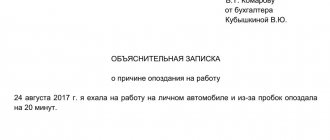Despite the absence of a unified form in the legislation, such a memo is often used and allows not only to formalize legal relations between employees, but also to officially contact the responsible person, immediate or senior manager, or representatives of other structural units with the initiative to bring the employee to disciplinary action.
The main purpose of this information and reference document is to record the current situation and convey important information related to the violation to the addressee. The decision whether to subject an employee to disciplinary action in each specific case is within the competence of the manager. The memo allows him to form an opinion on what happened and make a decision.
Purpose and types
During work, each employee can record the fact of failure to fulfill official duties by his colleague (or several colleagues) and initiate (as well as write independently) the preparation of a corresponding memorandum according to a certain sample or in any form.
The main purpose of such a measure is to record the actual fact of violation of internal regulations, for example:
- being late without a good reason;
- premature departure from work;
- absenteeism;
- appearing drunk;
- incorrect performance of one's duties;
- inaction resulting in consequences for the company and/or other employees;
- incorrect communication with colleagues, etc.
Can be used both inside and outside the enterprise. Therefore, they are divided into 2 types:
- Internal is the most common option when you need to convey the fact of incorrect work to a higher-ranking employee. Typically, the paper is drawn up on the company's letterhead, in accordance with the instructions provided by the enterprise (if any). To certify the document, it is enough to put only the signatures of the employees who witnessed the incident.
- External - in this case it is drawn up in the name of representatives of regulatory authorities or in the name of the head of the central office (i.e. the document goes outside the company). Such a paper can be drawn up in connection with incorrect actions of the manager, which employees report to a higher authority. This document must be certified by signatures and the seal of the organization.
In form, these papers are practically no different. The main thing is to take care of the evidence base, be ready to defend your point of view, and also take into account several mandatory requirements for drafting, which are discussed below.
How to correctly draw up a memo regarding failure to perform official duties
The memorandum is not regulated by any GOSTs and is drawn up according to established rules. The content depends on its compiler. If the written form is addressed to the management of the company, it refers to the internal form, but if it is sent outside the boundaries of the company, for example, to higher authorities, then it refers to the external one. External forms are drawn up on company letterhead, internal ones - on an ordinary A4 page.
The external message should display the following:
- Company name
- Type of message (memorandum);
- Departure date
- Postcode
- Locality of origin
- Sender
- Title to description
- Main content
- Signature of management representative
- FULL NAME. performer
- Contact phone number
For its registration, a company letterhead is most often used.
How to compose
As a rule, the company has its own templates and rules for drawing up reports when it is necessary to record the fact of non-fulfillment of official duties by a particular employee. Therefore, the form and content of the document are arbitrary. Usually the following drafting rules are followed:
- First of all, a “header” is drawn up, in which the full name of the director (or other responsible person) in whose name the paper is written is written. The short name of the company is also indicated.
- Then the name of the document and number are written down (usually in chronological order, which needs to be clarified in the document flow log).
- Next, you need to briefly but succinctly state the essence of the comment. Describes a fact, an incident that indicates incorrect performance of official duty, unprofessional actions or inaction. For example, late submission of reports, incorrect completion of documentation, lateness, incorrect communication with colleagues, etc.
- After this, you can justify the violation by qualifying it accordingly - for example, according to labor legislation (absenteeism, appearing in a state of intoxication) or in accordance with the internal regulations of the organization (for example, failure to comply with a professional standard when serving a customer at the checkout).
- If such actions (or inaction) entailed certain sanctions against the company, this fact must be described in detail. For example, “as a result of the inaction of employee Ivanov N.K. a fine of 10,000 rubles was imposed on the company by the tax inspectorate.”
- Next, the drafters of the paper must clearly state their request, starting the sentence with the word “I propose...”. Typically, certain disciplinary actions are proposed - for example, a reprimand, depreciation or even dismissal.
- Next, each person who participated in the drafting of the text (and was also a direct witness to the incident) puts his signature, and also writes down his last name, initials and the full name of the position he currently holds.
Considerations of business ethics exclude the description of any subjective opinions in the note. It is important to understand that the document specifically records the fact of violation of labor discipline, non-compliance with duties, therefore the text should reflect only the incident itself and propose a measure of responsibility in relation to the unscrupulous employee.
Complaint against an employee: where and how to file, sample
Each company attracts third parties who act as its employees and perform their job duties. Often these individuals enter into relationships with other people, acting on behalf of the organization. But it may happen that this employee comes into conflict with someone, and a third-party complaint is filed against the employee.
What behavior in the workplace is considered unlawful?
The Labor Code stipulates that any employee must communicate taking into account professional, corporate, and social norms.
Each employee must be familiarized with the adopted regulations upon signature. Thanks to this, he will have clear criteria by which his behavior will be assessed as unlawful.
Insult
This offense is expressed in the employee’s unlawful actions towards a third party, which led to the humiliation of his honor and dignity.
The use of obscene language, comparing an opponent with some animate or inanimate object, etc. can be considered an insult.
Very often, insults can be found between colleagues, as well as among superiors towards their subordinates.
Boorish behavior
Rudeness involves rude, insolent behavior or statements made by an employee. Most often, rudeness affects everyone around and is not directed at any person.
Usually, rudeness acts as an expression of the employee’s superiority over the people around him. Often this behavior can be found among colleagues who hide their incompetence.
Refusal to perform assigned duties
When signing an employment agreement between an employee and the administration, he undertakes to fulfill the duties assigned to him by this document. But sometimes a situation arises when an employee refuses to perform these duties.
This right is given to him by labor legislation, but only in situations where the administration does not fulfill its obligations to pay wages, or for other valid reasons.
Attention! In other situations, refusal to perform duties for an employee will be a serious disciplinary offense that may have consequences for him.
Manipulation can be observed not only between colleagues, but also between superiors and subordinates. Sometimes the fact of manipulation is very difficult to determine.
However, if the second, injured party detects the presence of manipulation, it can complain about this to higher authorities.
Attention! It is quite difficult to prove manipulation; in addition, this offense cannot be qualified as a disciplinary violation. Here, only public censure can be used to combat it.
In order to convey the fact of the incident to management, the victim must write a claim. It can come from both other employees and clients of the organization.
Types of complaints
Let's look at what types of complaints exist.
Individual
If a complaint against an employee is filed by one person - a colleague or a visitor, it will be considered individual.
The document must necessarily contain the applicant’s personal data, otherwise it may not be considered. This type of complaint is most often encountered in practice.
Collective
If the employee’s behavior affected the whole team, then all offended citizens can make a single collective complaint.
The most important thing here is that the rights of everyone who signs must be violated as a result of the incident. A collective complaint usually carries more weight.
complaints against an employee.
Claim structure
An individual or collective complaint against a work colleague must include the following information:
- Information about the organization or institution that is the recipient of the complaint;
- Information about the author of the document - his personal data and position. If the complaint is filed collectively, it is necessary to list all persons interested in the proceedings.
- Information about the offense committed - who did it, what the violation was, etc.
- Date when the complaint was written;
- Signature of the author of the appeal (or the signatures of all employees who wrote the collective complaint against the dishonest employee);
- Information about the documents that were drawn up to support the charges.
When composing the text of the complaint, you must adhere to the rules of business writing.
Submission methods
Therefore, it is best to do this in the following ways:
- In the hands of a secretary, a responsible employee of a government agency, etc. In this case, you must have two copies of the document with you, and the receiving person makes a note of receipt on the second one.
- By mail - in this case, before sending the document, you must fill out an inventory of the attachment at the post office, and the envelope itself must contain a notification of receipt by the addressee. Thus, the returned notice will be considered the fact of filing a complaint.
- You can file a complaint with some government agencies via the Internet online. In this case, the employee should receive an electronic receipt with the number assigned to the request.
Where to file a complaint
Complaint to management
The first step is to file a complaint against the employee to his superior manager. Such a document must be submitted through a secretary, and it must have an incoming registration number. Upon receipt of a written request, the applicant must give a written response.
In the submitted appeal, you must write in detail about the facts of the employee’s boorish behavior. However, when drawing up a document, it is imperative to follow the rules of business correspondence. When submitting an appeal to the manager, the text cannot indicate exactly how he should deal with the violator.
Labour Inspectorate
If boorish behavior at an enterprise comes from the manager, then you can file a complaint against him with the labor inspectorate. Upon request, an inspection must be carried out to establish facts of violation of the current legislation of Russia.
When submitting an appeal to a government agency, it is very important to provide evidence of such behavior, since it is unlikely that the manager will behave this way with inspectors.
Therefore, they can be used:
- Audio and video recording;
- Written testimony of eyewitnesses to the violation.
The consequence of contacting the labor inspectorate may be the imposition of a fine on the violator.
Prosecutor's office
If the labor inspectorate was unable to resolve the conflict, you can file a complaint with the prosecutor's office. Based on the results of the investigation, the perpetrator may be held accountable.
However, even in this situation, the author of the appeal must provide complete, indisputable evidence of boorish behavior towards him.
Class action
A situation may arise when an employee’s inappropriate behavior affects several people at once. In this case, they can file a complaint collectively.
Such a complaint can also be filed with the judicial authorities. Moreover, in this situation, you can receive various compensations through the court, not only provided by law, but also for moral damage.
Important! It is also necessary to take into account this point - evidence of the defendant’s guilt must be provided by the plaintiff. If the case in question involves boorish behavior, it is advisable for the plaintiff to have audio and video evidence of the incident.
When determining the period within which an enterprise must respond to a complaint received, it matters from whom it came.
If it comes from a government agency, then a response must be drawn up within thirty days. When a response letter requires additional information from third parties, this period may be extended by an additional thirty days.
Attention! When the response period is not defined by the standards, each company can determine its own period within reasonable limits in its regulations. For example, when writing a complaint, its authors often ask for an answer within 7-10 days.
The main requirement is that the company employees be familiarized with the acts that established them, upon signature.
Articles 192 and 193 of the Labor Code of the Russian Federation establish a strict list of penalties that an employer can apply to its employees:
- Announcements are made verbally.
- Issuance of a reprimand by order of management.
- Termination of an employment contract with an employee.
In order to apply disciplinary measures correctly, it is necessary to comply with established procedures, including the presentation by the employee of the company of an explanatory note in which he explains what happened.
If an employee refuses it, this does not mean that the employer cannot fire him for this.
It is also important to consider the period when an employee can be held accountable. By law, this time is limited to one month. The employer must remember that the same violation cannot be punished twice.
It is imperative to take into account that bonuses are awarded for compliance with certain established criteria.
If they are violated, then bonuses will not be paid. This is not a disciplinary punishment, but is considered a material consequence of the current situation.
The main thing is that the criteria by which bonuses are accrued or not accrued are recorded in the appropriate regulations and employees are familiarized with this act upon signature.
Who applies to whom?
There is no specific unified regulation. However, each company has its own procedure - both in written and oral form: usually all memos are submitted to:
- general director;
- his deputy;
- head of the branch;
- foreman
In this case, such a document is submitted either by senior employees or those at the same level - that is, precisely those who have registered the fact of insufficiently conscientious performance of duties.
Every person in the company has the right to write a note to any employee, regardless of his specific position. That is, theoretically, an ordinary employee can write a complaint to the general director against his immediate supervisor. In practice, every company has an unspoken order and its own hierarchy, but in principle all people have the opportunity to complain.
What kind of document is this?
Internal document flow of enterprises is necessary for formalizing requests or conveying information regarding production to higher authorities from their subordinates.
Such papers include:
- statements;
- office notes;
- explanatory;
- reports.
Many people are familiar with the statement, explanatory and service notes. But what is a report? Does this document have legal status? Let's figure it out.
Heads of departments know well from their own experience that there are employees who often ignore the rules of conduct at work.
Some of them, after the remark he made, behave more disciplined. But others don’t seem to “hear” that they are being scolded for being late, absenteeism, or showing up at work drunk.
Of course, such particularly malicious violators of labor discipline must be thoroughly punished or even dismissed before an emergency occurs due to their fault.
The head of the department does not directly have the opportunity to directly influence the employee so that he can tangibly feel it.
In this case, it is very important, as a punishment, to deprive the violator of labor discipline of additional pay or to fire him for absenteeism. However, this can only be done in accordance with the law.
To do this, first of all, you need to convey information about what happened to senior management.
The fact of the violations must be stated in a memorandum and in the same document, ask the authorities to take corrective action against the negligent employee.
After this appeal, the head of the organization must decide for himself what punishment to impose.
In production, the report will be an official confirmation of a disciplinary violation committed by an employee of the enterprise.
Such a document has legal force. She was assigned a number according to OKUD - 0286041, in contrast to the memo.
For example, if an employee was fired for repeated absenteeism, then when checking the organization’s personnel service by labor inspectors, they will need to provide reports as evidence of the fact of violations.
This will allow the company to avoid an administrative fine.
In what cases is it necessary?
The main goal pursued by the compiler of the memo is to officially report to management the disciplinary violation that has occurred.
The procedure for applying the document and presenting information in writing is set out in Article 193 of the Labor Code of the Russian Federation.
A violator who has ignored the rules of labor discipline can be punished only after written confirmation of the fact of his negative act.
The list of violations of labor regulations and discipline for drawing up a report includes the following events:
- failure to comply with safety standards;
- ignoring orders from the head of the unit and other services;
- performing official duties incompletely;
- alcohol intoxication of a worker was detected during a work shift;
- immoral behavior in the workplace that offends the dignity of other employees;
- systematic delays at the beginning of the working day;
- absenteeism;
- premature departure before the end of the shift;
- avoidance of training in order to improve one's qualifications;
- delaying time with a medical examination;
- willful behavior that violates the rules of labor discipline;
- theft and deliberate damage to company property.
Each individual case may entail punishment for violation of labor discipline standards if the employee’s explanatory statement does not confirm that he has good reasons for such actions.
Specifics
It is important to realize that this type of internal documentation such as reports has its own specific characteristics.
It is as follows:
- Unlike other options, this type of note is addressed exclusively to higher management according to the chain of command. Moreover, these can only be officials who will actually make a real decision and implement it.
- The information presented in the report must be reliable and confirm the fact of violation of labor discipline.
- The note should prompt the manager to punish or hold accountable an employee who does not perform his work duties well.
It is important to know that gross and systematic violation of labor discipline rules can lead to the dismissal of an employee under Article 81 of the Labor Code of the Russian Federation.
Thus, the employer has the right to terminate the employment contract with the employee due to his frequent lateness to work or failure to comply with the working hours.
Differences from an official and explanatory note
A memo has many similar properties to an official memo.
But there are significant differences between them:
- the official report is addressed to equivalent employees with its compiler, and the report is addressed only to those of higher rank;
- unlike a memo, a memo is not provided for by OKUD;
- Depending on the situation, a memo can be written by an employee on his own initiative or by order of his superiors or other authorized persons.
- the report has legal force.
The fact of violation of the labor regime described in the memorandum may lead to the imposition of disciplinary action on the employee.
There are several types of punishments:
- comment;
- rebuke;
- dismissal.
The manager must make a decision on disciplinary action based on the employee’s report and explanatory note, written at the request of the enterprise administration.
Is there a unified form?
Like other internal documentation, the memorandum must be prepared in accordance with the standards of GOST 6.30–2003 “Unified documentation systems. Unified system of organizational and administrative documentation. Documentation requirements."
The writer of the memo must clearly know how it should be written.
If, when preparing it during the writing process, significant deviations from the norms or errors are made, then it will not have legal force during the resolution of controversial situations.
It cannot be used as evidence of violation of labor discipline.
If a line manager undertakes to provide information in writing about an employee’s violation of labor discipline, then in order for the document to acquire legal status, it is necessary to adhere to the recommendations for its execution.
What is staffing? Read in the article. How to apply for a replacement during sick leave? Find out here.
Registration procedure
In different organizations, the procedure for recording facts of violation of labor discipline and written confirmation may be different, but in general the sequence of actions is as follows:
- The fact of violation of discipline, dishonest performance or complete failure to fulfill duties is recorded. You can use audio and video recording equipment, and involve other workers as witnesses.
- The text of the note is compiled.
- The paper is certified by the responsible person - as a rule, this is a senior salesman, shift supervisor, foreman, HR manager and other employees.
- Then the paper is submitted directly to the manager in whose name it was drawn up.
- The manager considers the appeal on its merits, takes action and issues his own order (order) or rejects the appeal, if necessary, explaining the reasons for the refusal to the employees who issued it.
General requirements for compilation
A memo is a document with the help of which information about a violation of discipline is brought to the attention of the head of a department or organization.
Although there are cases when information should be conveyed to a higher authority. This results in a conditional division into internal and external documents. Use a business style of presentation and avoid emotions if you want to be “heard”. Excessive passions will reduce the degree of confidence in the information: the reader may immediately get the idea that the author is not guided by arguments, but by personal hostility, self-interest, or a desire to screw over the person he is complaining about.
Sample and examples
In general, you can use the following form as a basis:
Below we consider several examples of memos that can be taken as a sample if it is necessary to record the fact of an employee’s failure to fulfill his official duties.
Nuances
It is important for the author of the memo to understand that this document can become evidence in resolving controversial issues.
Its design must comply with the above rules in order for it to have legal force.
Violation of labor discipline can lead to unforeseen consequences, so the text must be presented briefly and at the same time focus on its essence with strong evidence and accusations.
Since the document deals with a specific employee, it is important to take into account legal norms in the analytical and recommendatory part.
You can even consult a lawyer if you have any doubts, and then refer to his recommendations to propose your solution in the current situation.
Attention!
- Due to frequent changes in legislation, information sometimes becomes outdated faster than we can update it on the website.
- All cases are very individual and depend on many factors. Basic information does not guarantee a solution to your specific problems.
That's why FREE expert consultants work for you around the clock!
- via the form (below), or via online chat
- Call the hotline:
- 8 (800) 700 95 53
APPLICATIONS AND CALLS ARE ACCEPTED 24/7 and 7 days a week.
Personnel
Types of disciplinary sanctions
At the moment, all penalties that can be applied to an employee come down to 3 types:
- Written comment.
- Drawing up a reprimand.
- Involuntary dismissal due to insufficient work performance.
At the same time, the Labor Code states that no other types of penalties are allowed. Management can choose any of these measures, and in some cases we are immediately talking about issuing a reprimand or even dismissal, so the employer is not obliged to follow the given sequence.
However, the order of application of the measure must be taken into account - in general it consists of the following actions:
- The fact of failure to fulfill official duties is recorded, as a result of which a report can be drawn up according to the established template. Drawing up this paper is the right, but not the obligation of the employer.
- The employee must be required to draw up an explanatory note - i.e. a written explanation of the reasons for his action (or inaction).
- If he refuses to comply with this requirement, an appropriate act must be drawn up, which is signed by witnesses (colleagues).
- Next, a measure is implemented that is supposed to be responsible for the action - a remark is recorded, a reprimand is issued, or the employee is immediately forcibly dismissed.
A violation can be recorded within a maximum of 6 months from the day it was committed by the employee. That is, if an incident is discovered after this period, it will be impossible to initiate a disciplinary procedure. Although going to court cannot be ruled out.
More details about disciplinary actions can be seen here.
Is it possible to cancel the punishment?
After the memo about failure to fulfill official duties has been issued, the decision to issue an order to bring the employee to disciplinary liability has been made, it may be necessary to cancel it early. In accordance with Article 194 of the Labor Code of the Russian Federation, if within a year from the date of announcement the employee is not subject to disciplinary action, then it is considered lifted. Thus, the employer, before the expiration of a year from the date of application of the disciplinary sanction, has the right to remove it from the employee on his own initiative, at the request of the employee himself, at the request of his immediate supervisor or a representative body of employees.
The absence of outstanding disciplinary penalties in the Regulations on remuneration of budgetary and non-profit organizations and institutions, as a rule, is a prerequisite for the accrual of various incentive payments, bonuses based on the results of work for the year, nomination for awards, and transfer to a higher position.
Reprimand: instructions for drawing up
After a failure to fulfill official duties has been noted, about which a report has been drawn up according to the appropriate sample, employers most often take two measures - a reprimand or a reprimand. It is important to understand that only one measure is applied for one offense.
As a rule, management makes a decision on a reprimand, which is communicated in a written order (order). At the same time, neither the form of the reprimand nor the form of this order is established, therefore each company has the right to use its own forms and samples. Typically the document contains the following sections:
- Date, place of drawing up the order, full official name of the organization.
- The name and number of the order in accordance with accepted document flow rules (usually in chronological order).
- Actually a statement of the contents of the order. Information about the employee is provided (full name, position, personnel number if available, other essential information) and the reason for the reprimand. Links to regulatory documents are described - labor legislation, internal regulations, as well as evidentiary papers (for example, a memorandum).
- Applications are described - that is, documents that are attached to the order indicating the quantity and type (copy or original).
- A stamp, signature of the director and transcript (last name, initials) are affixed.
A sample order is presented below:
NOTE. The order must always be signed by the employee - it is assumed that by these actions he confirms the fact that he has read the text, but this does not mean that he agrees with the content. If an employee refuses to sign, a corresponding act of refusal is drawn up, which is signed by other employees of the organization who attest to this fact.
How to write - step by step instructions
Since there are no uniform requirements for filling out the document, different organizations may have their own templates for conducting internal official correspondence. Thus, a service letter can be compiled in any form, taking into account certain general requirements for structure.
- The “header” of the document, designed along the right edge of the page, indicates:
- position of the manager to whom the memo is addressed (first line);
- last name, first name, patronymic of the manager (second line);
- position of the person drawing up the document (third line);
- last name, first name, patronymic of the compiler (fourth line).
- In the title of the document, which is placed in the center of the sheet, it is written:
- title “Office memo” (first line);
- date of preparation and serial number of the document (second line);
- further – the subheading “about non-fulfillment (regarding non-fulfillment) of official (official) duties (instructions)”, the position of the employee for whom the note is drawn up, his last name, first name, patronymic (in full).
- The “body” of the document should state:
- a description of the situation in which the employee did not fulfill his official duties, indicating specific dates and circumstances, as well as a link to the relevant points of the job description that was violated;
- a description of the consequences that resulted from the colleague’s inappropriate attitude to work (if any);
- statement of the request (demand) to apply measures of influence on the employee (punishment).
- At the end of the document there must be a signature of the person making it with a transcript (last name, initials).
Relevant acts (if any have been drawn up) may be attached to the document, which should be mentioned in the document, for example: “The act of violation of labor discipline is attached.”
Sample report
Memos can be very different in style and content , as they will always bear the imprint of the characteristics of the profession and type of activity, as well as the personal characteristics of the compiler. This is, for example, what a “service letter” about violation of official duties of people in creative professions may look like.
To the director of the Pogorelovsky Drama and Comedy Theater, Shutov Vikenty Lvovich Director-producer Stanislav Danilovich Nemirovsky 01/14/2018 No. 2
Internal memo regarding failure to fulfill official duties by costume designer Pyotr Semenovich Brazhnikov
I would like to bring to your attention that theater employee P.S. Brazhnikov, showing up for work drunk, disrupted the performance for corporate clients “My Old Year is My Best Holiday” on January 14, 2018, because he was unable to properly prepare costumes for the actors (Clause 5.1 of the job description). As a result, the actress Nadezhda Ivanovna Bednenkaya, who was supposed to play Pippi Longstocking, was forced to go on stage in stockings of the same size (short), which grossly violated the development of the script.
In connection with such circumstances, I demand that P.S. Brazhnikov be punished. issuing a severe reprimand.
Stage director (signature) Nemirovsky S.D. Actors: Pravdolyubov S.K. (signatures) Mezhdometev P.Kh. Lizobludova G.V.
You will learn about the rules for preparing official memos in accordance with GOST in another material.
General concepts and general requirements for any memo. Summary
An internal memorandum is an official document adopted in the company’s internal document flow. Compiling it correctly is important for setting up successful communication. The recipient must clearly understand what the sender wants to tell him. To do this, the document must indicate the following points:
- Exact numbers (for example, salary, bonuses).
- Dates (for example, the date an employee was sent on a business trip).
- List of grounds for the measures specified in the memo.
- A list of material objects that are present in the sender’s request.
- Information about all persons who appear in the note.
The note begins with a “header”, which contains information about the persons participating in the communication and the name of the organization. You also need to register information with the company. At the end of the note, you must indicate the date, signature and its transcript.
Recently, official memos have been practiced, which are sent via e-mail. However, the classic option is written drafting.
We can say that drawing up such notes is a way of communication between employees of the same level. For example, they can be sent from the head of a department to the general director. Usually the head of a department asks for his employees.
If ordinary employees write a note, it will be considered a report. Whether the sender’s requests will be accepted depends on the correct drafting of the memo. The recipient must clearly understand what is being asked of him and why. It is necessary to write down all the official information, but do it briefly and succinctly.
Rules and procedure for compilation
Sample report
There is no legally established concept of “Internal Memo”, and therefore there is no strictly established form for writing it. Each employee can compose it in free form or according to a template developed and approved by the enterprise.
You can write a document either by hand or print it on a computer, but in both cases it must contain the “living” signature of the author. Sometimes heads of organizations require that internal memos be written on letterhead and must be certified by the signatures of responsible persons. Usually this document is written in one copy, but if necessary, you can make a copy of it.
The main requirement is that the note must always contain information
- about the name of the enterprise,
- the date of its preparation,
- the employee who writes the note,
- the official to whom she is sent.
Also, the note must clearly indicate the specific problem and possible ways to solve it.
If a memo is written by an ordinary employee, then it is advisable to have it certified by the head of the department, who thus indicates that he is familiar with the problem and agrees with the proposed options for eliminating it.
After writing, the memo must be registered in the internal documents log so that its traces are not lost in the document flow.
Despite the fact that the note does not have a unified template, from the point of view of office work, the design is quite standard.
- In the upper right corner of the document, you should first indicate the addressee: to whom it is sent (position, full name of the company, last name, first name, patronymic of the employee). Then, in the same way, you need to enter information about the employee who is the author of the note.
- Next, on the right, you should enter the name of the document, as well as the date of its preparation and the internal document flow number. Here you must indicate the locality in which the enterprise whose employee is writing the note is registered.
- After this, you should briefly title the document (i.e., briefly outline the problem to which it is devoted).
- The second part of the note should be devoted to the essence of the problem. It must be described in detail, indicating other officials who are involved in it. Further in the note you need to offer options for resolving the issue that has arisen.
- In conclusion, the note must be signed by the author (with a mandatory transcript of the signature) and, if necessary, submitted to the head of the department for approval.
We suggest you read: How to reduce the tax base for an apartment










